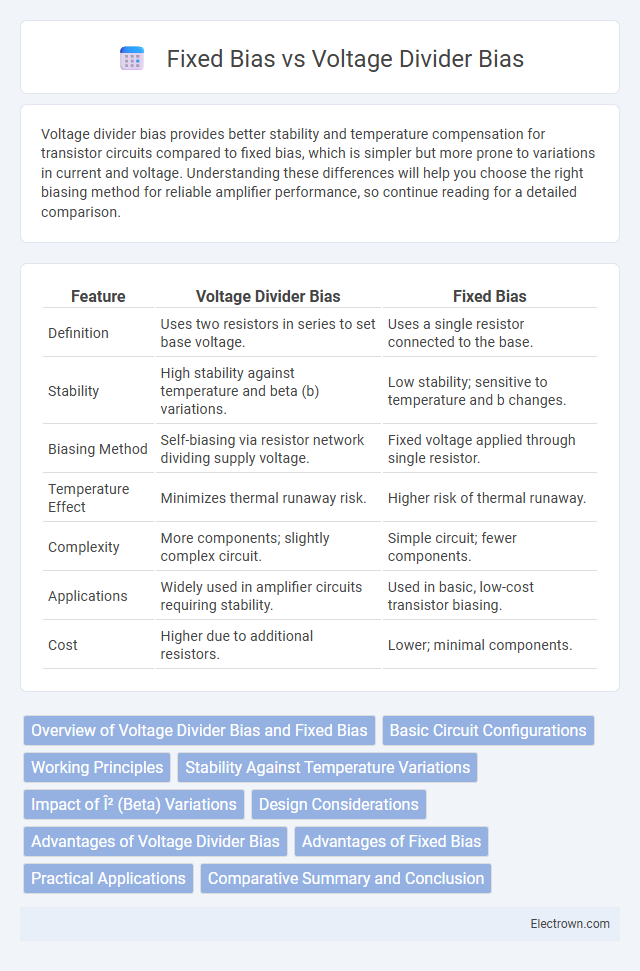Voltage divider bias provides better stability and temperature compensation for transistor circuits compared to fixed bias, which is simpler but more prone to variations in current and voltage. Understanding these differences will help you choose the right biasing method for reliable amplifier performance, so continue reading for a detailed comparison.
Table of Comparison
| Feature | Voltage Divider Bias | Fixed Bias |
|---|---|---|
| Definition | Uses two resistors in series to set base voltage. | Uses a single resistor connected to the base. |
| Stability | High stability against temperature and beta (b) variations. | Low stability; sensitive to temperature and b changes. |
| Biasing Method | Self-biasing via resistor network dividing supply voltage. | Fixed voltage applied through single resistor. |
| Temperature Effect | Minimizes thermal runaway risk. | Higher risk of thermal runaway. |
| Complexity | More components; slightly complex circuit. | Simple circuit; fewer components. |
| Applications | Widely used in amplifier circuits requiring stability. | Used in basic, low-cost transistor biasing. |
| Cost | Higher due to additional resistors. | Lower; minimal components. |
Overview of Voltage Divider Bias and Fixed Bias
Voltage divider bias provides stable transistor operation by using two resistors to set a precise base voltage, reducing sensitivity to variations in transistor parameters and temperature changes. Fixed bias, on the other hand, directly applies a constant voltage to the base through a single resistor, resulting in less stability and greater variation in transistor performance. Your choice between these biasing methods impacts circuit reliability and efficiency, with voltage divider bias offering superior control and consistency.
Basic Circuit Configurations
Voltage divider bias features two resistors connected in series across the power supply, providing a stable and predictable base voltage through a voltage dividing action, which enhances transistor stability against temperature variations. Fixed bias uses a single resistor connected to the transistor base, delivering a fixed base current but offering less thermal stability and more sensitivity to transistor parameter changes. Your choice between these basic circuit configurations depends on the desired bias stability and operating point consistency in transistor amplifier designs.
Working Principles
Voltage divider bias operates by creating a stable reference voltage through a pair of resistors connected in series across the power supply, ensuring consistent base current despite variations in transistor parameters or temperature. Fixed bias relies on a single resistor connected between the base and the power supply, making the base current directly dependent on the resistor value and transistor beta, resulting in less stability. The voltage divider bias circuit offers improved thermal stability and predictable operating point compared to the simpler but less reliable fixed bias configuration.
Stability Against Temperature Variations
Voltage divider bias offers superior stability against temperature variations compared to fixed bias because it uses a pair of resistors to establish a stable base voltage, reducing the impact of transistor parameter changes. Fixed bias circuits are more susceptible to fluctuations since the base current depends directly on the input voltage and base-emitter junction characteristics, which vary with temperature. Your circuits will maintain more consistent operating points with voltage divider bias, enhancing overall reliability in varying thermal conditions.
Impact of β (Beta) Variations
Voltage divider bias provides greater stability against variations in transistor current gain (b) by using two resistors to establish a stable base voltage, minimizing changes in operating point. Fixed bias circuits are highly sensitive to b variations, causing significant shifts in collector current and operating point, reducing reliability. The improved b insensitivity in voltage divider bias makes it preferred for consistent amplifier performance across different transistors.
Design Considerations
Voltage divider bias offers greater stability against variations in transistor beta (b) compared to fixed bias, making it a preferred choice for consistent operating points. The design requires selecting two resistors to form a voltage divider that provides a stable base voltage, which reduces sensitivity to temperature changes and transistor replacement. Fixed bias circuits are simpler but require careful adjustment of the base resistor to maintain biasing, often leading to less reliable performance in your amplifier design.
Advantages of Voltage Divider Bias
Voltage divider bias provides improved stability of the operating point against variations in transistor parameters and temperature changes, ensuring consistent circuit performance. It offers better biasing precision by using two resistors to set the base voltage, minimizing the influence of transistor beta variations. Your electronic circuits benefit from enhanced reliability and reduced distortion, making voltage divider bias the preferred method over fixed bias in most amplifier designs.
Advantages of Fixed Bias
Fixed bias circuits offer a simple design with minimal components, making them cost-effective and easy to implement in small-signal transistor applications. They provide a predictable operating point under constant temperature conditions, ensuring straightforward biasing for initial circuit setup. This simplicity allows for rapid prototyping and quick adjustments during circuit testing phases.
Practical Applications
Voltage divider bias is widely used in amplifier circuits for providing stable operating points despite temperature variations and transistor parameter changes, making it ideal for audio amplifiers and signal processing. Fixed bias circuits, simpler but less stable, are often employed in low-cost or low-frequency applications where precision is not critical, such as small signal switching or initial prototyping. Your choice between the two impacts circuit reliability and performance in practical electronic design scenarios.
Comparative Summary and Conclusion
Voltage divider bias offers improved stability against temperature variations and transistor parameter changes compared to fixed bias, which relies on a single resistor making it less reliable. Fixed bias circuits are simpler and cost-effective but suffer from lower DC stability, limiting their practical applications in precision amplifiers. Voltage divider bias is preferred for consistent operating points and enhanced performance in transistor amplifier designs.
voltage divider bias vs fixed bias Infographic

 electrown.com
electrown.com